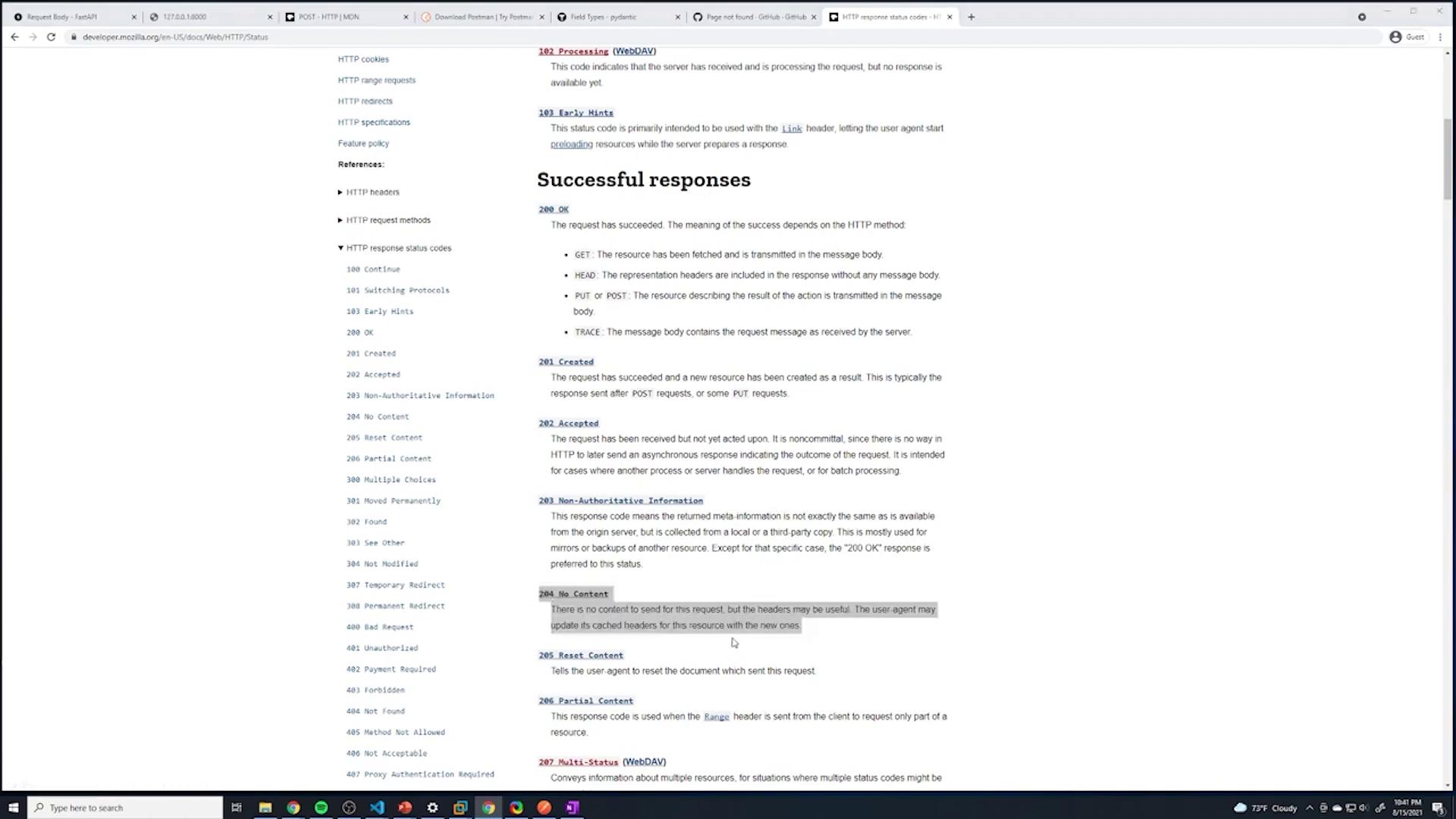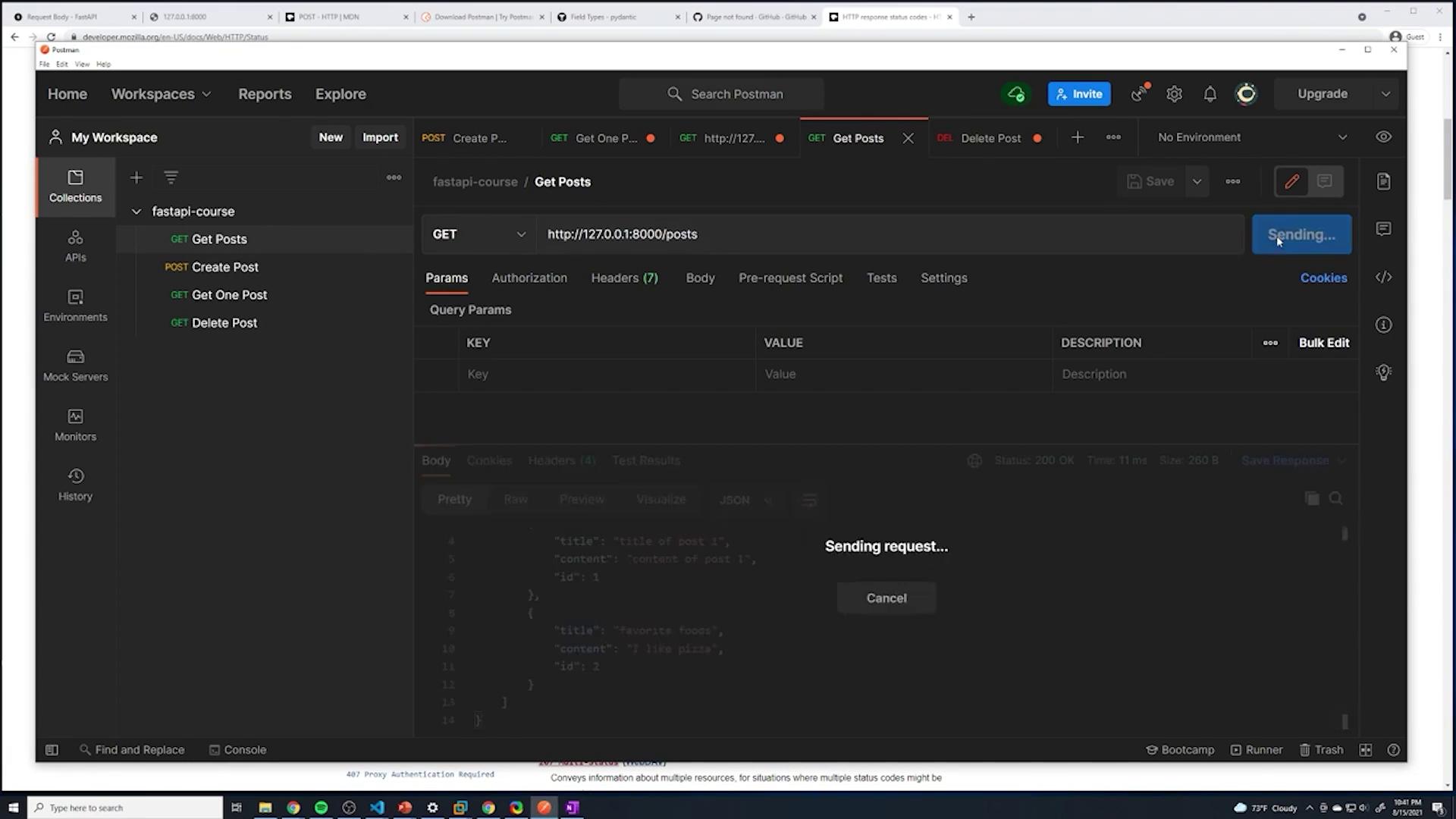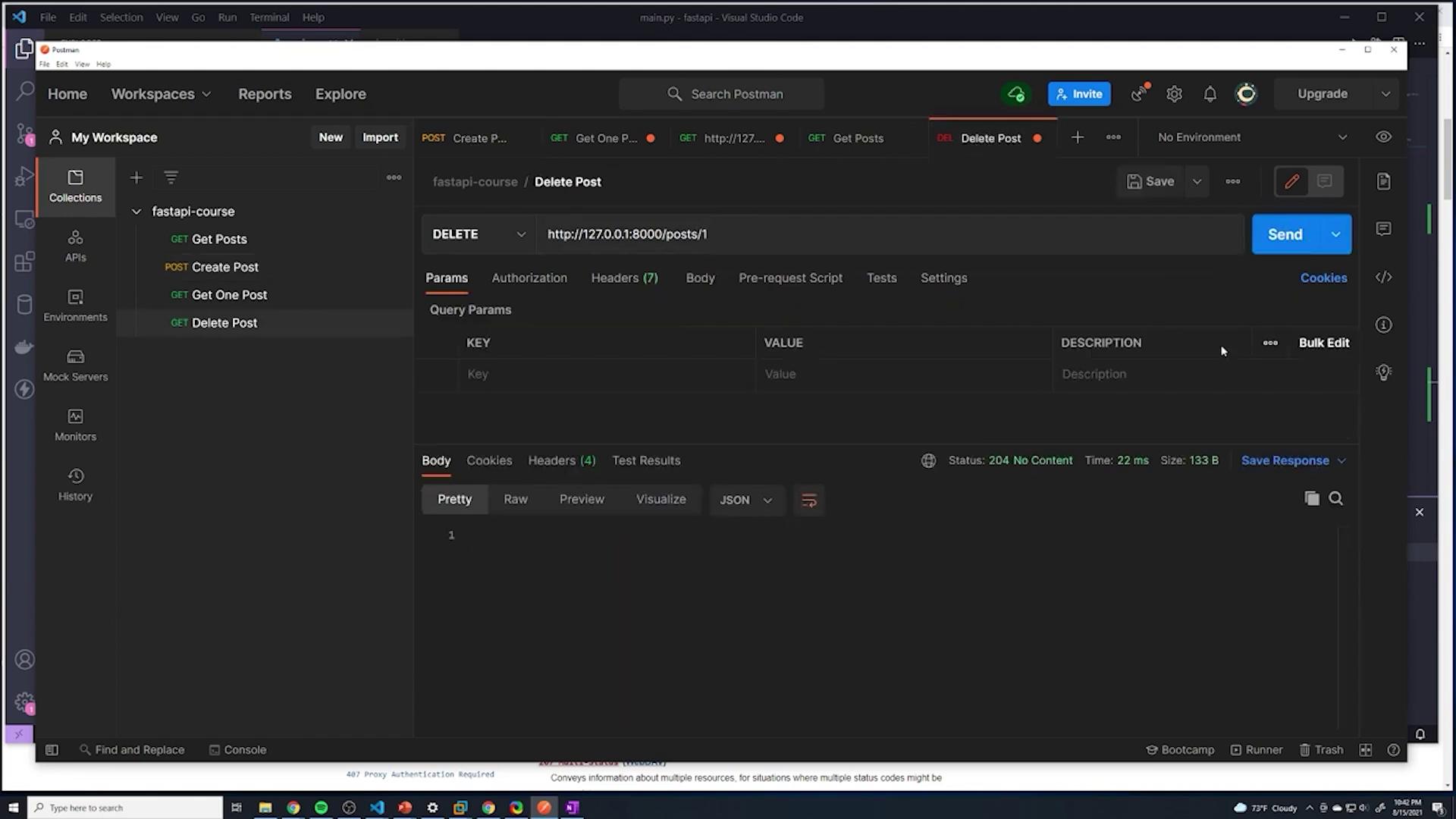Python API Development with FastAPI
FastAPI Basics
Deleting Posts
In this lesson, we'll learn how to implement a DELETE endpoint in FastAPI to remove a post based on its ID. By following this guide, you will understand how to:
- Verify a post exists using a GET endpoint.
- Remove a post from an in-memory list.
- Handle scenarios where the post is not found.
- Return the appropriate HTTP response, using a 204 status code for a successful deletion.
Note
Before deleting a post, ensure you have helper functions in place to locate the post and its index within your list.
Below is an outline of the solution:
- Retrieve a single post using a GET endpoint for verification.
- Define the DELETE endpoint to:
- Accept the post ID via the URL.
- Find the index of the post with the given ID.
- Remove the post from the list.
- Return a response with a 204 status code if deleted, or a 404 error if not found.
Defining the GET Endpoint for a Single Post
We start by defining a simple GET endpoint that retrieves a post by its ID. If the post isn’t found, an HTTPException with a 404 status code is raised.
@app.get("/posts/{id}")
def get_post(id: int):
post = find_post(id)
if not post:
raise HTTPException(
status_code=status.HTTP_404_NOT_FOUND,
detail=f"Post {id} was not found"
)
return {"post_detail": post}
Starting the DELETE Endpoint Implementation
When creating the DELETE endpoint, ensure the post ID is included in the URL. Initially, the function signature might look like this:
@app.delete("/posts/{id}")
def delete_post():
However, this is incomplete because we need to accept the post ID as a parameter.
Implementing the Deletion Logic
The deletion process involves:
- Locating the specific post (dictionary) in the in-memory array using its ID.
- Removing it with the list method
pop().
A simplified snippet for finding a matching post looks like this:
for p in my_posts:
if p['id'] == id:
return p
Later, we use a similar strategy to find the index of the post for deletion.
Full Example with Helper Functions
Below is a complete example that sets up the FastAPI application along with helper functions to locate a post and its index for deletion. Notice the use of the enumerate() function in find_index_post.
from typing import Optional
from fastapi import FastAPI, Response, status, HTTPException
from pydantic import BaseModel
from random import randrange
app = FastAPI()
class Post(BaseModel):
title: str
content: str
published: bool = True
rating: Optional[int] = None
my_posts = [
{"title": "title of post 1", "content": "content of post 1", "id": 1},
{"title": "favorite foods", "content": "I like pizza", "id": 2}
]
def find_post(id: int):
for p in my_posts:
if p['id'] == id:
return p
def find_index_post(id: int):
for i, p in enumerate(my_posts):
if p['id'] == id:
return i
@app.get("/")
def root():
return {"message": "Hello World"}
@app.get("/posts")
def get_posts():
return {"data": my_posts}
@app.post("/posts", status_code=status.HTTP_201_CREATED)
def create_posts(post: Post):
post_dict = post.dict()
post_dict['id'] = randrange(0, 1000000)
my_posts.append(post_dict)
return {"data": post_dict}
@app.get("/posts/{id}")
def get_post(id: int):
post = find_post(id)
if not post:
raise HTTPException(
status_code=status.HTTP_404_NOT_FOUND,
detail=f"Post with id: {id} was not found"
)
return {"post_detail": post}
Implementing the DELETE Endpoint Correctly
To implement the DELETE endpoint correctly, update the endpoint to include the post ID in the function parameters, handle scenarios where the post cannot be found, and return a 204 status code (No Content) on success.
@app.delete("/posts/{id}", status_code=status.HTTP_204_NO_CONTENT)
def delete_post(id: int):
# Find the index matching the given post ID
index = find_index_post(id)
if index is None:
raise HTTPException(
status_code=status.HTTP_404_NOT_FOUND,
detail=f"Post with ID {id} does not exist"
)
my_posts.pop(index)
return Response(status_code=status.HTTP_204_NO_CONTENT)
Warning
Do not include any content in the response body when using a 204 status code, as this might cause errors related to the declared Content-Length.
Testing the DELETE Endpoint
You can test the DELETE endpoint using tools like Postman. For example, sending a DELETE request to remove the post with ID 1 might initially yield an error like:
TypeError: 'NoneType' object cannot be interpreted as an integer
This error indicates that the helper function find_index_post returned None, meaning that the post with the specified ID does not exist. Once the conditional check is added, attempting to delete a non-existent post will raise an HTTPException with a 404 status code.
When the deletion is successful, the server will log a 204 No Content response:
INFO: 127.0.0.1:61307 - "GET /posts HTTP/1.1" 200 OK
...
INFO: 127.0.0.1:51801 - "DELETE /posts/1 HTTP/1.1" 204 No Content
The image below from the MDN documentation shows various HTTP response status codes, including the expected 204 code for a successful deletion.

After deleting the post, running a GET request to retrieve all posts confirms that the post has been removed:

Verifying Deletion with the Updated Status Code
The final DELETE endpoint returns a 204 status code with no content, which is shown in the following snippet:
@app.delete("/posts/{id}", status_code=status.HTTP_204_NO_CONTENT)
def delete_post(id: int):
# Find the index in the list based on the given post ID
index = find_index_post(id)
if index is None:
raise HTTPException(
status_code=status.HTTP_404_NOT_FOUND,
detail=f"Post with ID {id} does not exist"
)
my_posts.pop(index)
return Response(status_code=status.HTTP_204_NO_CONTENT)
Sending a DELETE request now returns a 204 response with no content:

Conclusion
In this article, we demonstrated how to implement a DELETE endpoint in FastAPI to remove posts from an in-memory list. Key takeaways include:
- Using a GET endpoint to verify a post's existence.
- Implementing logic to remove a post by locating its index.
- Handling errors when a post is not found.
- Returning a 204 No Content response upon successful deletion.
In the next lesson, we will explore how to update posts in FastAPI. Happy coding!
Additional Resources
Watch Video
Watch video content